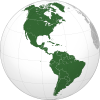- Demographics of Haiti
-
Although Haiti averages approximately 255 people per square kilometer (650 per sq. mi.), its population is concentrated most heavily in urban areas, coastal plains, and valleys. About 80-85% of Haitians are of predominantly West African descent.[1][not in citation given] The remainder of the population is primarily mulattoes. There are tiny Arab, Asian and European communities. Hispanic residents in Haiti are mostly Cuban and Dominican. About two thirds of the Haitian population live in rural areas.
Although there was a national census taken in Haiti in 2003, much of that data has not been released to the public. Several demographic studies, including those by social work researcher Athena Kolbe have shed light on the current status of urban residents. In 2006 households averaged 4.5 members. The median age was 25 years with a mean average age of 27 years. People aged 15 and younger counted for roughly a third of the population. Overall, 52.7 percent of the population was female. [2]
Contents
Languages
Taíno was the major pre-Columbian language in the region now known as Haiti. One of the country's official languages is Haitian Creole, a French-based creole with African influences, as well as minor Spanish and Taíno influences. French is the other official language. Spanish, though not official, is spoken by a growing amount of the population. It is spoken more frequently near the border with the Dominican Republic. English is increasingly spoken among the young and in the business sector.
Religion
The state religion is Roman Catholicism which 80-85% of the population professes. 15-20% of Haitians practice Protestantism. A significant percentage of the population also practice Vodou traditions approximately 20-25%, but these claims are denied by a significant amount of the strict[citation needed] Roman Catholic populace.[citation needed] Haitians that do practice both faiths however tend to see no conflict in these African-rooted beliefs co-existing with the Roman Catholic faith.[citation needed]
Education
Although public education is free, private and parochial schools provide around 75% of educational programs offered. Less than 65% of children of primary school age are actually enrolled. At the secondary level, the figure drops to 55%. Of those enrolled in primary school, 63% will complete it. On average, it takes 16 years to produce a single graduate of the 6-year cycle.[clarification needed] Though Haitians place a high value on education,[citation needed] few can afford to send their children to secondary school.[citation needed] Remittances sent by Haitians living abroad are important in paying educational costs.[citation needed]
In the metropolitan area of Port-au-Prince, home to 2.21 million of Haiti's 8.5 million people, only 23 percent of adults have completed secondary school with 16 percent passing the state graduation exam. [3] More than half (53.5 percent) of children aged 5-17 do not attend school. [4]
Emigration
Large-scale emigration, principally to the United States, and Canada (predominantly to Quebec, with other areas of the country) - but also to Cuba, other areas of Europe and the Americas such as France (with French Guiana), Spain, Belgium, the United Kingdom and Ireland; and Venezuela, the Dominican Republic, the Bahamas and other Caribbean neighbors - has created what Haitians refer to as the Eleventh Department or the Diaspora. About one of every six Haitians live abroad.
CIA World Factbook demographic statistics
The following demographic statistics are from the CIA World Factbook (as of March 3rd, 2011[update]).[5]
Population: 9,719,932 (2011 est.)†
Age structure: (2010 est.)
- 0–14 years: 38.1% (male 1,735,917; female 1,704,383)
- 15–64 years: 58.5% (male 2,621,059; female 2,665,447)
- 65 years and over: 3.4% (male 120,040; female 188,690)
Median age: (2010 est.)
- Total: 21.1 years
- Male: 20.9 years
- Female: 21.4 years
Population growth rate: 0.787% (2011 est.)‡
Birth rate: 24.4 births/1,000 population (2011 est.)
Death rate: 8.21 deaths/1,000 population (2011 est.)‡
Net migration rate: -8.32 migrant(s)/1,000 population (2011 est.)
Sex ratio: (2010 est.)
- At birth: 1.011 male(s)/female
- Under 15 years: 1.02 male(s)/female
- 15–64 years: 0.99 male(s)/female
- 65 years and over: 0.62 male(s)/female
- Total population: 0.98 male(s)/female
Infant mortality rate: (2011 est.)‡
- Total: 54.02 deaths/1,000 live births
- Male: 58.16 deaths/1,000 live births
- Female: 49.83 deaths/1,000 live births
Life expectancy at birth: (2011 est.)‡
- Total population: 62.17 years
- Male: 60.84 years
- Female: 63.53 years
Total fertility rate: 3.07 children born/woman (2011 est.)
Nationality:
- Noun: Haitian(s)
- Adjective: Haitian
- Ethnic groups: Black 95%, Mulatto and White 5%
Religions: Roman Catholic 80%, Protestant 16% (Baptist 10%, Pentecostal 4%, Adventist 1%, other 1%), none 1%, other 3%
Languages: French (official), Haitian Creole (official), Spanish (non-official)
Literacy: (2008 est. by IHSI)[6]
- Definition: Age 15 and over that can read and write
- Total population: 61.0%
- Male: 63.8%
- Female: 58.3%
References
- ^ CIA - The World Factbook -- Haiti
- ^ Kolbe, Athena R.; Royce A. Hutson (August 31, 2006). "Human rights abuse and other criminal violations in Port-au-Prince, Haiti: a random survey of households". The Lancet. doi:10.1016/S0140-6736(06)69211-8. http://www.ijdh.org/pdf/Lancet%20Article%208-06.pdf. Retrieved 20 June 2011.
- ^ Kolbe, Athena R.; Royce A. Hutson (August 31, 2006). "Human rights abuse and other criminal violations in Port-au-Prince, Haiti: a random survey of households". The Lancet. doi:10.1016/S0140-6736(06)69211-8. http://www.ijdh.org/pdf/Lancet%20Article%208-06.pdf. Retrieved 20 June 2011.
- ^ Kolbe, Athena R.; Royce A. Hutson (August 31, 2006). "Human rights abuse and other criminal violations in Port-au-Prince, Haiti: a random survey of households". The Lancet. doi:10.1016/S0140-6736(06)69211-8. http://www.ijdh.org/pdf/Lancet%20Article%208-06.pdf. Retrieved 20 June 2011.
- ^ "Haiti". The World Factbook. Central Intelligence Agency. Archived from the original on 2011-03-03. http://www.webcitation.org/5wu9PoobA.
† note: estimates for this country explicitly take into account the effects of excess mortality due to AIDS; this can result in lower life expectancy, higher infant mortality and death rates, lower population and growth rates, and changes in the distribution of population by age and sex than would otherwise be expected
‡ note: the preliminary 2011 numbers differ significantly from those of 2010, which were strongly influenced by the demographic effect of the January 2010 earthquake; the latest figures more closely correspond to those of 2009 - ^ Institut Haitien de Statistique et d'Informatique - IHSI
 Haiti topics
Haiti topicsHistory Timeline · Saint-Domingue · Revolution · U.S. occupation · 1915-1986 · 2004 rebellion · 2010 earthquakeGeography Governance Constitution · Foreign relations · Government · Law enforcement · Military · Parliament · President · Prime Minister · Supreme CourtPolitics Economy Agriculture · Airports · Central bank · Communications · Currency · External debt · Foreign aid · Transport · Tourism · Water supply and sanitation · MediaSociety Culture Demographics of the Americas Sovereign states - Antigua and Barbuda
- Argentina
- Bahamas
- Barbados
- Belize
- Bolivia
- Brazil
- Canada
- Chile
- Colombia
- Costa Rica
- Cuba
- Dominica
- Dominican Republic
- Ecuador
- El Salvador
- Grenada
- Guatemala
- Guyana
- Haiti
- Honduras
- Jamaica
- Mexico
- Nicaragua
- Panama
- Paraguay
- Peru
- Saint Kitts and Nevis
- Saint Lucia
- Saint Vincent and the Grenadines
- Suriname
- Trinidad and Tobago
- United States
- Uruguay
- Venezuela

Dependencies and
other territories- Anguilla
- Aruba
- Bermuda
- Bonaire
- British Virgin Islands
- Cayman Islands
- Curaçao
- Falkland Islands
- French Guiana
- Greenland
- Guadeloupe
- Martinique
- Montserrat
- Navassa Island
- Puerto Rico
- Saint Barthélemy
- Saint Martin
- Saint Pierre and Miquelon
- Saba
- Sint Eustatius
- Sint Maarten
- South Georgia and the South Sandwich Islands
- Turks and Caicos Islands
- US Virgin Islands
African diaspora By region AmericasAnglo AmericaBahamas · Belize · Canada (Black Nova Scotians) · Grenada · Guyana · Jamaica (Igbo Jamaican · Coromantee · Jamaican Maroons) · Trinidad & Tobago · United States (Black Hispanic · Black Indians in the U.S. · Black Seminoles · Multiracial American)Hispanic AmericaOther countriesBrazil (Pardo) · Suriname (Surinamese Creoles · Surinamese Maroons)
South Asia Europe Middle East Demographics: LGBT topics (Traditional religions)Categories:
Wikimedia Foundation. 2010.

